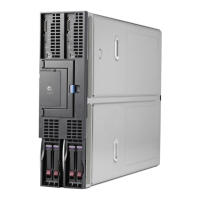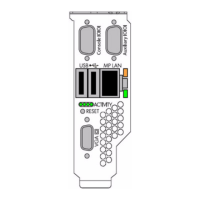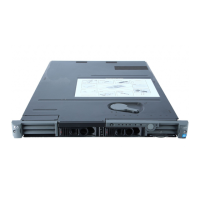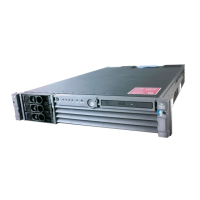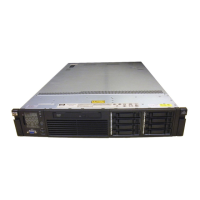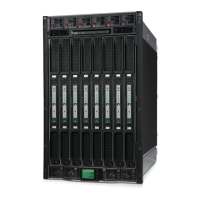







Do you have a question about the HP Integrity BL860c and is the answer not in the manual?
Details on intended audience, new information, document organization, and typographic conventions.
Information on how to contact HP support, including contact details and required information.
Details on server blade dimensions, components, SAS disk drives, backplane, and I/O subsystems.
Information on PCI expansion blades, memory subsystem, DIMMs, and memory configurations.
Details on adding memory and updating server blade firmware.
Details on power subsystem, processor complex, enclosure info, and controls/ports/LEDs.
Description of front panel LEDs, including server health, NICs, and SAS disk drive status.
Information on the SUV cable, its ports, and the server blade's rear panel connectors.
Safety precautions, installation sequence, unpacking, and handling of server blade components.
Verifying site prep, inspecting shipping, unpacking, inventory, and managing component returns.
Procedures for installing internal components and removing/replacing the access panel.
Step-by-step guide for installing a processor into the server blade.
Procedure for installing memory DIMMs, including installation order and configuration.
Instructions for installing mezzanine cards into PCIe x4 and PCIe x8 ports.
Steps for installing the server blade into the c-Class enclosure and initial power-up.
Procedure to access the iLO 2 MP using DHCP for initial configuration and diagnostics.
Steps for connecting the SUV cable and a terminal for server blade access.
Methods to access the iLO 2 MP after initial connection, including network and serial ports.
Steps to configure remote access, including setting static IP addresses and securing access.
Procedures for enabling or disabling remote access and configuring static IP addresses.
Guides on using EFI Boot Manager and booting the operating system.
Details on rear panel port locations and server blade to enclosure interconnect mapping.
Information on using MPTUTIL for updating adapter firmware and drivers.
Detailed steps for flashing firmware on SAS HBAs and BIOS/EFI drivers.
Guide to using the DRVCFG utility, including screen navigation and adapter properties.
Details on selecting array types, creating new arrays, and viewing array properties.
Procedures for synchronizing, activating, deleting arrays, and exiting the SAS utility.
Explains CFGGEN utility usage, rules for IM volumes, and hot spare disks.
Details on CFGGEN commands for creating IM volumes and hot spares.
Steps to verify and download the latest server blade firmware.
Lists supported OS and covers installing OS via USB DVD.
Guides for installing OS using HP Ignite-UX and vMedia.
Details on managing boot options list and configuring autoboot settings.
Steps for adding HP-UX to boot options and various booting methods.
Procedure for booting HP-UX in single-user mode via EFI Shell.
Steps to boot HP-UX in LVM-maintenance mode.
Procedure for adding OpenVMS entries to the system boot options list.
Steps for shutting down the HP OpenVMS operating system.
Procedure to add Microsoft Windows entries to the system boot options list.
Instructions for shutting down Windows via the command line.
Procedure for adding Linux entries to the system boot options list.
Steps for booting the Red Hat Enterprise Linux operating system.
General methodology for troubleshooting server blade errors and faults.
Introduction to troubleshooting tools, including front panel LEDs.
Details on NIC and SAS disk drive LED states and meanings.
Information on online diagnostic tools and their functionalities.
Overview of fault management strategies and HP-UX fault management.
Explanation of event logs, their definitions, and how to use them for error analysis.
Procedure for troubleshooting server build-up issues when power is on but POST fails.
Guidance on troubleshooting processors, memory DIMMs, installation, and configuration.
Details on I/O subsystem behaviors, messaging policies, and rope-to-ACPI paths.
Information on identifying and troubleshooting firmware problems and performing updates.
Guidance on how to report server problems to HP support and collect necessary information.
Details on required service tools and procedures for removing/replacing SAS disk drives.
Steps for replacing SAS disk drives and disk drive blanks.
Procedures for preparing the server blade for servicing and powering it off.
Step-by-step guide for removing and replacing the server blade from the enclosure.
Instructions for removing and replacing the server blade's access panel.
Procedure for removing and replacing memory DIMMs.
Steps for replacing a DIMM, ensuring correct installation.
Step-by-step guide for installing a processor into the server blade.
Procedure for installing the SAS backplane into the server blade.
Steps for replacing the front display assembly on the server blade.
Procedure for replacing the server battery on the system board.
Steps for replacing a mezzanine card on the system board.
Procedure for removing a cache module from the server blade controller board.
Steps for replacing the BBWC battery, including cable connections.
Procedure for installing a new TPM onto the system board.
Steps for installing a new system board into the server blade.
List of customer replaceable units (CRUs) and their part numbers for the server blade.
Information on processor upgrades, compatibility, and required firmware/OS levels.
Guides on downloading, installing, and using the NVRAM backup utility.
Overview of EFI commands for managing boot options and system configuration.
Examples of using EFI/POSSE commands for help and utility operations.
Details on baud rate settings and boottest utility for speedy boot.
Information on default settings, clearing NVM, and errdump for processor memory logs.
Examples of using the 'info' command for system, CPU, memory, and I/O details.
Details on lanaddress for MAC addresses and monarch for bootstrap processor ID.
Information on specifying parameters for utilities and using the setup utility.
Details on EFI shell paths for devices and booting from a file.
Configuration of boot next setting and auto boot timeout.
Procedures for selecting active console input and error devices.
Configuration of security settings, passwords, and the Integrated Lights Out 2 Management Processor.
| Form Factor | Blade |
|---|---|
| Processor | Intel Itanium 2 |
| Number of Processors | 2 |
| Memory | Up to 128 GB |
| Memory Slots | 16 |
| Processor Speed | 1.6 GHz |
| Memory Type | DDR2 SDRAM |
| Hard Drive Form Factor | SFF |
| Operating Systems | HP-UX, Linux, Windows Server |
| Power Supply | Redundant, hot-swappable power supplies |
